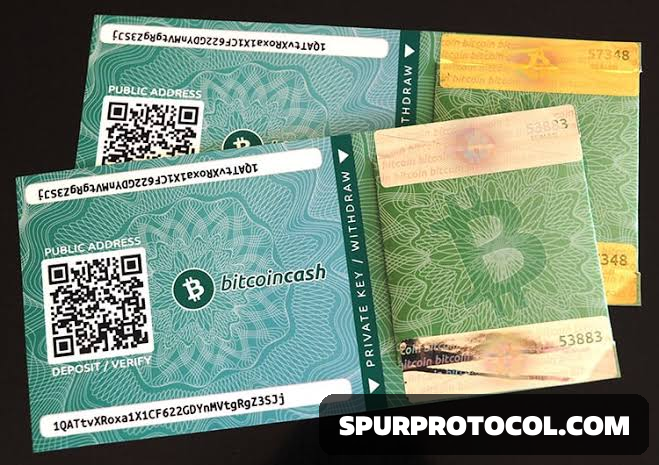Paper wallet
- A paper wallet is a sheet of paper that has the user's private and public keys. Or, in other words, a physical storage system.
- Cryptocurrencies are digital assets, so a paper wallet provides them with a system to securely keep unique keys to users' virtual funds.
- Besides, the keys can be maintained in their alphanumeric raw form or printed as a QR code.
How Paper Wallets Work
- Paper wallets function by leveraging the principles of public and private key cryptography.
- When you generate a paper wallet, it creates a unique set of keys one public and one private. The public key, sometimes represented as a QR code, allows you to receive cryptocurrency by sharing it with others.
- The paper wallet private key, which must remain confidential, is the key to accessing and managing your funds.
- Paper wallets work entirely offline, which reduces the risk of digital theft.
- To create one, you typically use an open-source generator that runs on your computer without needing an internet connection.
- This ensures that the keys are not exposed to any potential online threats during the generation process.
- Once the wallet is created, you print or write down the keys, and the wallet can now receive funds. However, the process of spending or transferring the funds from the wallet requires importing the private key into a digital wallet software.
- The security of paper wallets lies in the fact that the private key never exists in a digital form outside of the brief moment when it is generated.
- Once printed or written, the key can be stored safely offline.
How to Create and Use a Paper Wallet
Paper wallets are usually generated using an app. However, there are many ways to create a paper wallet, the most simple of which is to write your keys and seed phrases on paper with a pen.
If you'd rather not write so many letters and numbers (64 digits per key), you could use these steps to create your own paper wallet:
-Choose and install your app
- Make sure you're disconnected from the internet and other devices
- Create your wallet
- Decide the number of copies you want to print
- Enter a PIN or password to encrypt your wallet if prompted
- Generate your wallet
- Print
- Don't forget to delete any history, cookies, clear your browsing cache, and remove the app if necessary.
Once you have the wallet printed, you can safely remove your keys from your wallet device or app. If you want to restore your keys to your wallet device, you can use its scanning option or enter the keys manually to use them.
Benefits of Paper Wallets
1. Enhanced Security
Paper wallets are immune to cyber threats such as malware, phishing, or hacking attempts because they exist entirely offline.
2. Cost-Effective
Unlike hardware wallets, which may require a financial investment, creating a paper wallet is essentially free. All you need is a printer, paper, and a secure way to store the printed document.
3. Control Over Funds
A paper wallet gives complete control to the user.
- There are no third-party intermediaries or dependencies on software services, meaning that as long as you have access to the physical wallet, you control the funds.
4. Long-Term Cold Storage
For individuals looking to hold cryptocurrency long-term, paper wallets provide an easy way to store funds without needing constant management or software updates. Once the wallet is generated and stored, no further action is required.
Disadvantages of Paper Wallets
1. Physical Vulnerability
One of the greatest risks to paper wallets is their physical nature. Paper can easily be damaged by fire, water, or general wear and tear. If the wallet is lost or destroyed, access to the associated cryptocurrency is permanently lost as well.
2. Human Error
The process of creating a paper wallet involves several manual steps, including writing or printing keys and storing them safely. Any error in this process such as misplacing the paper, printing a corrupted version, or failing to record the keys correctly can result in permanent loss of funds.
3. Difficult to Access Funds
Unlike hardware or software wallets, which provide easy and convenient access to your funds, paper wallets are cumbersome to use. To spend or transfer cryptocurrency, the private key must be imported into a digital wallet, adding complexity and the potential for user mistakes.
4. No Backup Mechanism
Since a paper wallet is a physical object, there is no built-in backup mechanism. If the paper is lost, stolen, or destroyed, the cryptocurrency is lost as well. Some users create multiple copies, but this introduces new security risks by increasing the chances of unauthorized access.
5. Less Practical for Regular Use
Paper wallets are not designed for everyday transactions. They are best suited for long-term holding, as importing private keys repeatedly to access funds is inefficient and introduces additional risks with each use.

